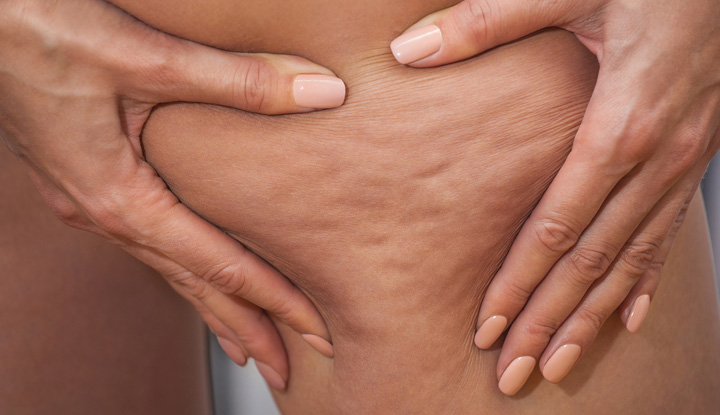What Is Cellulite?
Cellulite refers to the dimpled, lumpy appearance of the skin, most commonly found on the thighs, buttocks, hips, and abdomen. It develops when fat deposits push through the connective tissue beneath the skin. This creates a rippled texture that many describe as resembling orange peel or cottage cheese.
Cellulite is not a disease or medical concern—it’s a natural occurrence. Nearly 90% of women and 10% of men experience some degree of cellulite during their lives, and it can affect people of all sizes and fitness levels.
What Causes Cellulite?
Understanding what causes cellulite is key to separating fact from fiction. Several factors contribute to its development, including:
- Hormonal changes: Estrogen, insulin, and thyroid hormones play roles in fat storage and connective tissue structure.
- Genetics: Your genetic makeup influences fat distribution, skin structure, and circulation.
- Lifestyle habits: Poor diet, dehydration, smoking, and lack of physical activity can weaken the skin and connective tissues.
- Age: As skin loses elasticity and collagen with age, cellulite becomes more visible.
- Skin thickness: Thinner skin tends to reveal the uneven fat layers beneath more easily.
8 Common Myths About Cellulite – Debunked for Good
Cellulite is one of the most misunderstood skin concerns, affecting both men and women regardless of age or weight. Unfortunately, this widespread condition is often surrounded by myths and misinformation. If you’ve ever searched for how to get rid of cellulite or wondered what causes cellulite, you’ve likely encountered some misleading claims. In this article, we’re separating fact from fiction and giving you clear answers backed by science.
Myth 1: You Can Diet Your Way to a Cellulite-Free Body
Reality: While a balanced diet and healthy weight loss can improve overall skin tone and reduce fat, they won’t necessarily erase cellulite. That’s because cellulite is caused by fat being pushed against connective tissues beneath the skin. Even after significant weight loss, these underlying structures remain and can still create a dimpled appearance.
In fact, dramatic weight loss can sometimes make cellulite more visible due to decreased skin elasticity and volume. That’s why treatments like Cellulaze® are often recommended. This minimally invasive laser therapy targets the structural issues beneath the skin, liquefies trapped fat, and boosts collagen production to restore firmness and smoothness.
Myth 2: Exercise Will Eliminate Cellulite
Reality: Regular physical activity is essential for improving muscle tone and circulation, but it won’t eliminate cellulite on its own. Even elite athletes often struggle with cellulite because it’s not simply a matter of fitness—it’s structural. Cellulite occurs due to fat deposits pushing through connective tissue, which exercise alone cannot repair.
However, combining strength training with treatments that target the skin’s structure—such as Cellulaze—can lead to better, longer-lasting results.
Myth 3: Men Don’t Get Cellulite
Reality: While cellulite is more common in women (about 90% compared to just 10% of men), men are not immune. Differences in skin thickness, fat distribution, and connective tissue patterns make cellulite less visible in men—but it can still occur, especially in areas like the thighs, abdomen, and upper arms.
The good news? Cellulaze works effectively for both men and women, targeting the root causes of cellulite beneath the surface.
Myth 4: Only Overweight People Get Cellulite
Reality: Cellulite is not just a concern for those who are overweight. Thin and fit individuals can also develop cellulite because it only takes a small amount of fat to push through weakened or rigid connective tissue and cause dimpling. Factors like genetics, hormones, skin thickness, and collagen levels play a significant role in its appearance.
Being lean may reduce the overall visibility of cellulite, but it doesn’t eliminate the underlying issue.
Myth 5: Topical Creams Can Eliminate Cellulite
Reality: Many skincare brands promise miracle results with creams and lotions, but these products can only offer temporary, superficial improvements. While they may hydrate your skin or boost circulation slightly, they don’t address the deeper structural issues causing cellulite.
On the other hand, Cellulaze laser treatments work beneath the skin’s surface—melting fat, releasing connective bands, and stimulating collagen production for lasting results.
Myth 6: Liposuction Gets Rid of Cellulite
Reality: Liposuction removes fat—but it doesn’t smooth out cellulite. In fact, in some cases, liposuction can make cellulite worse by creating more surface irregularities. That’s because liposuction doesn’t treat the fibrous bands that cause skin dimpling.
If you’re considering a procedure, opt for treatments like Cellulaze that specifically target the structure of cellulite, not just fat volume.
Myth 7: Compression Clothing Minimizes Cellulite
Reality: Wearing tight garments or compression clothing might make your skin appear smoother temporarily, but as soon as you remove the clothing, the cellulite returns unchanged. These garments do not affect the fat cells or connective tissues beneath your skin, so they’re not a long-term solution.
Myth 8: Detox Diets or Supplements Can Cure Cellulite
Reality: Despite popular claims, there is no supplement, detox plan, or cleansing diet that can eliminate cellulite. These approaches may help you feel healthier and reduce bloating, but they can’t restructure the skin’s connective tissue or target underlying fat deposits.
A nutritious diet and regular exercise remain crucial for healthy skin and body composition, but for meaningful cellulite reduction, professional treatment is required.
Stop Believing the Myths About Cellulite
Cellulite is natural, common, and nothing to be ashamed of. However, if you’re frustrated by its appearance, it’s important to stop believing the widespread myths about cellulite and start focusing on real, science-backed solutions. One of the most effective treatments available today is Cellulaze, which targets the root causes of cellulite beneath the skin.
To discover how Cellulaze can help you achieve smoother, firmer skin, schedule a consultation today. Let’s take the first step toward real, lasting results.
Frequently Asked Questions About Cellulite
1. What is cellulite?
Cellulite is a condition where fat deposits push through the connective tissue beneath the skin, creating a lumpy, dimpled appearance—most commonly on the thighs, buttocks, and abdomen.
2. What causes cellulite?
Cellulite is caused by a combination of factors including genetics, hormones, age, poor circulation, skin structure, and the buildup of fat under the skin.
3. Does weight loss help reduce cellulite?
Weight loss may help reduce the visibility of cellulite by decreasing fat, but it doesn’t guarantee full removal since cellulite also depends on skin elasticity and connective tissue structure.
4. Can men get cellulite too?
Yes, while cellulite is more common in women, men can also develop it, especially on the thighs, abdomen, and upper arms.
5. Are creams effective for cellulite?
Most over-the-counter creams offer temporary improvement by moisturizing the skin but do not treat the root causes of cellulite.
6. Is cellulite a sign of poor health?
No, cellulite is not a medical concern or indicator of poor health. It affects people of all body types, including those who are fit and healthy.


